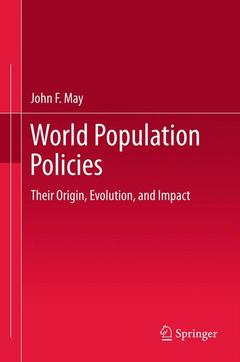Description
World Population Policies, 2012
Their Origin, Evolution, and Impact
Author: May John F.
Language: English
Subjects for World Population Policies:
Keywords
Changing age structures; Fertility; Future demographic growth; HIV/AIDS; High; medium and low fertility countries; Induced abortion; Malthusianism and Marxism; Migration; Mortality; Population aging; Population policies; Public health and population programs; Reproductive health; Reproductive rights; Vanguard family planning program; World demographic patterns and trends
Approximative price 105.49 €
In Print (Delivery period: 15 days).
Add to cartPublication date: 04-2014
340 p. · 15.5x23.5 cm · Paperback
Approximative price 105.49 €
In Print (Delivery period: 15 days).
Add to cartPublication date: 03-2012
340 p. · 15.5x23.5 cm · Paperback
Description
/li>Contents
/li>Biography
/li>Comment
/li>
This book examines the history behind the formulation, implementation, and evaluation of population policies in the more developed, the less developed, and the least developed countries from 1950 until today, as well as their future prospects. It links population policies with the theories of the demographic, epidemiological, and migratory transitions. It begins by summarizing the demographic situation around the world, with an emphasis on population policies and their underlying theories. Then, it reviews the early efforts to reduce mortality and fertility in the developing countries. This is followed by a description of the internationalization of the debate on population issues and the transformation of these programs into more formal population policies, particularly in the developing countries. The book reviews also the situation of the developed countries and their specific challenges ? sub-replacement fertility, population aging, and immigration ? and examines the effectiveness of population policies. It also explores the way forward and future prospects for population policies over the next decades. The book provides numerous concrete examples from all over the world, and show how population policies are actually implemented and what have been their successes as well as their constraints. Above all, the book highlights the importance of understanding underlying demographic trends when assessing the development prospects of any country.
The book is recommended for not only demographers, social scientists, and policymakers but also economists and political scientists who are interested in social and demographic change around the world. Demography students and researchers who are interested in applying knowledge on population trends and prospects in designing and evaluating public policies will find this an invaluable reference work.
John F. May, a Belgian national, is a Lead Demographer at the World Bank, and a specialist in population policies and programs. Prior to joining the World Bank in 1997, he worked on many population projects around the world for UNFPA, UNICEF, USAID, and the International Union for the Scientific Study of Population (IUSSP). He was posted in Haiti, West Indies, and New Caledonia, South Pacific for the United Nations. He came to the US in 1987 and was appointed Senior Scientist at The Futures Group International, a consulting firm offering services in population and HIV/AIDS modeling, policy, and program design. In 1991-1992, he spent a year as a Visiting Scholar at the Population Reference Bureau (PRB) and was a PRB Visiting Scholar again in 2006, 2007, and 2011. He is also an Adjunct Professor of Demography at Georgetown University, Washington, DC. He earned a BA in Modern History (1973) and a MA in Demography (1985) from the Catholic University of Louvain (Belgium), and a Doctorate in Demography (1996) from the University of Paris-V (Sorbonne).
The most exhaustive and comprehensive treatment of this historically important subject written to date
Covers all components of demographic growth and their related policies
Offers concrete examples of population policies and their implementation challenges




